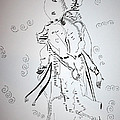20% off all products! Sale ends tonight at midnight EST.
Joined
2009
Followers
380
Visitors
1,454,349

Folk Dance Denmark
Danish folk dance is very old. In fact most dances are from around 1780-1880. That might not sound that old, but the fact is, that most other countries has folk dances that is much younger... (from 1840-1930, actually). The Danish dances were danced by the farmers and the poor people (that's why it's called folk dance - dances for the mass). These people wasn't allowed to dance the dances danced in higher circles - for example the were not allowed to dance menuette (french dance - very popular in noble circles in the 16-19th century) and dances like that. Instead they had their own dances which could be quite advanced. There were ring-dances, 2, 3 and 4 pair dances, 3-person dances (if there was a shortage of men each man had two female dancers ...), 8-pair dances, and row-dances. And, of course, single pair dances. The dominating types are 4-pair dances and the ring-dances. The woman's jewelry was a status-symbol. The nicer dressed she were, the more money the man had. Often most spare money went to buy silver chains for the locking of the female vest, a little (or big) brooch and silver/gold threads for the Bonnet. Especially the bonnets can be extremely rich decorated and weight several hundred grams. The bonnet often consisted of a "over the top" part and a "neck". This neck can be breathtaking beautiful. Under the bonnet were mostly worn a embroidered linen-piece to protect the bonnet, and to enhance the framing of the face, created by the bonnet. The back of the bonnet mostly contained a bow with the ends hanging down behind. The color of this bow could be used to determine weather the girl was married or not. A few places the bonnet were substituted with some other kind of cap. Embroidery was an important part of a costume. Everything from the socks to the head-clothing can be embroidered. Often in a stunning amount of details - boring winternights has been an unknown word for the housewife. On shirts are often embroidered when it was created, its number - and the monogram of he or she, who owned it. There do exist thousands of different clothing pieces. Each area had it's own way of putting the things together, and looking at a correct produced costume, you will be capable of identifying the area that costume comes from, down to a few square kilometers.